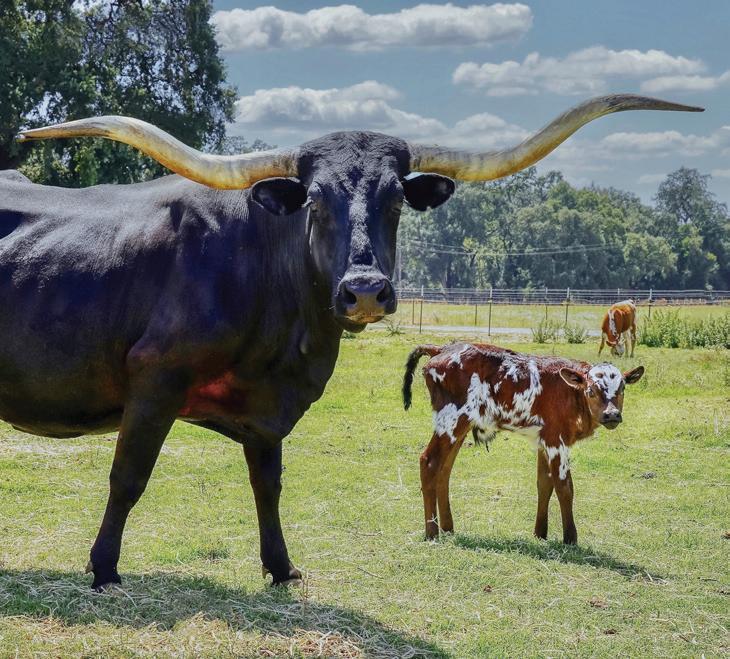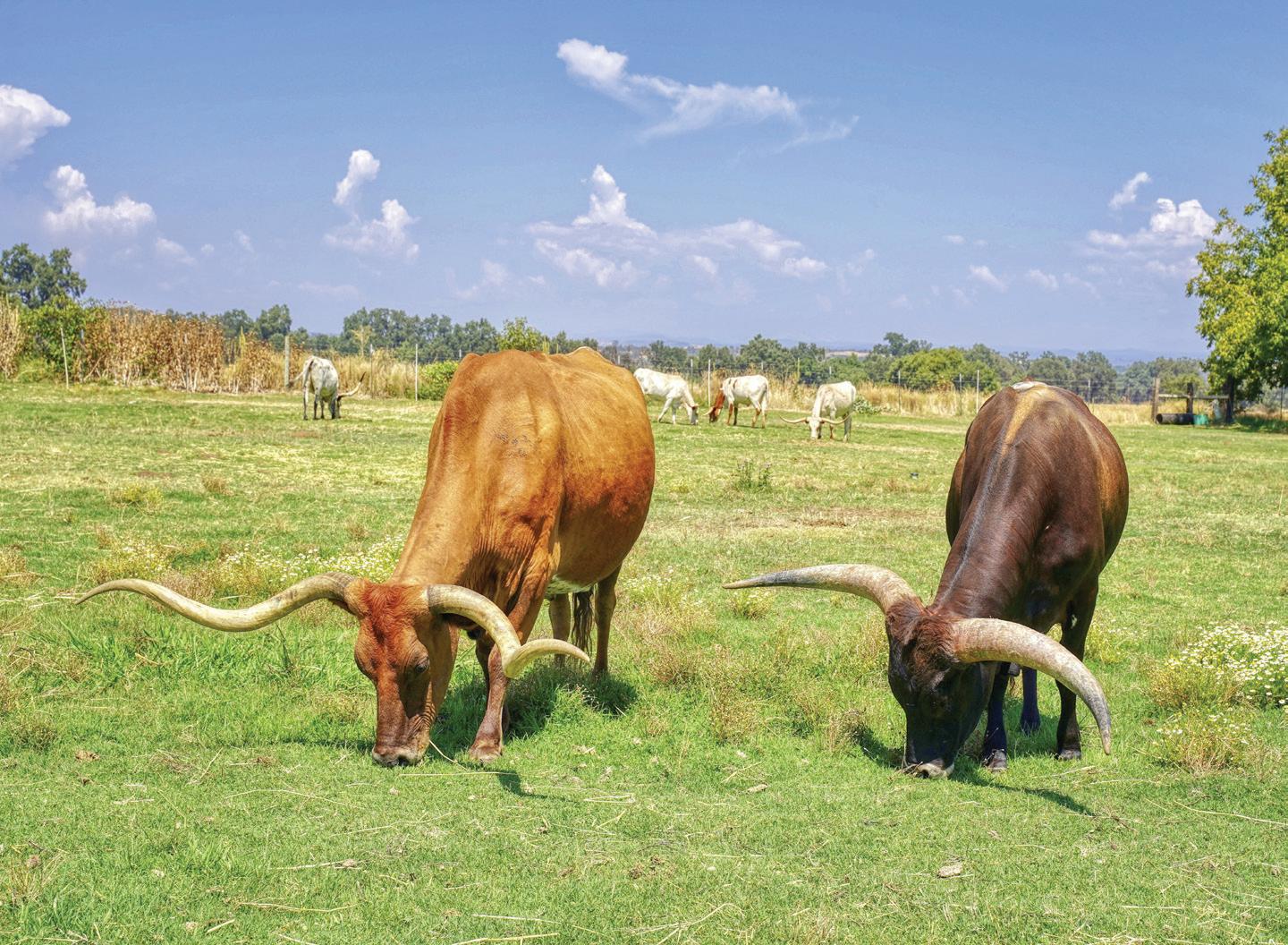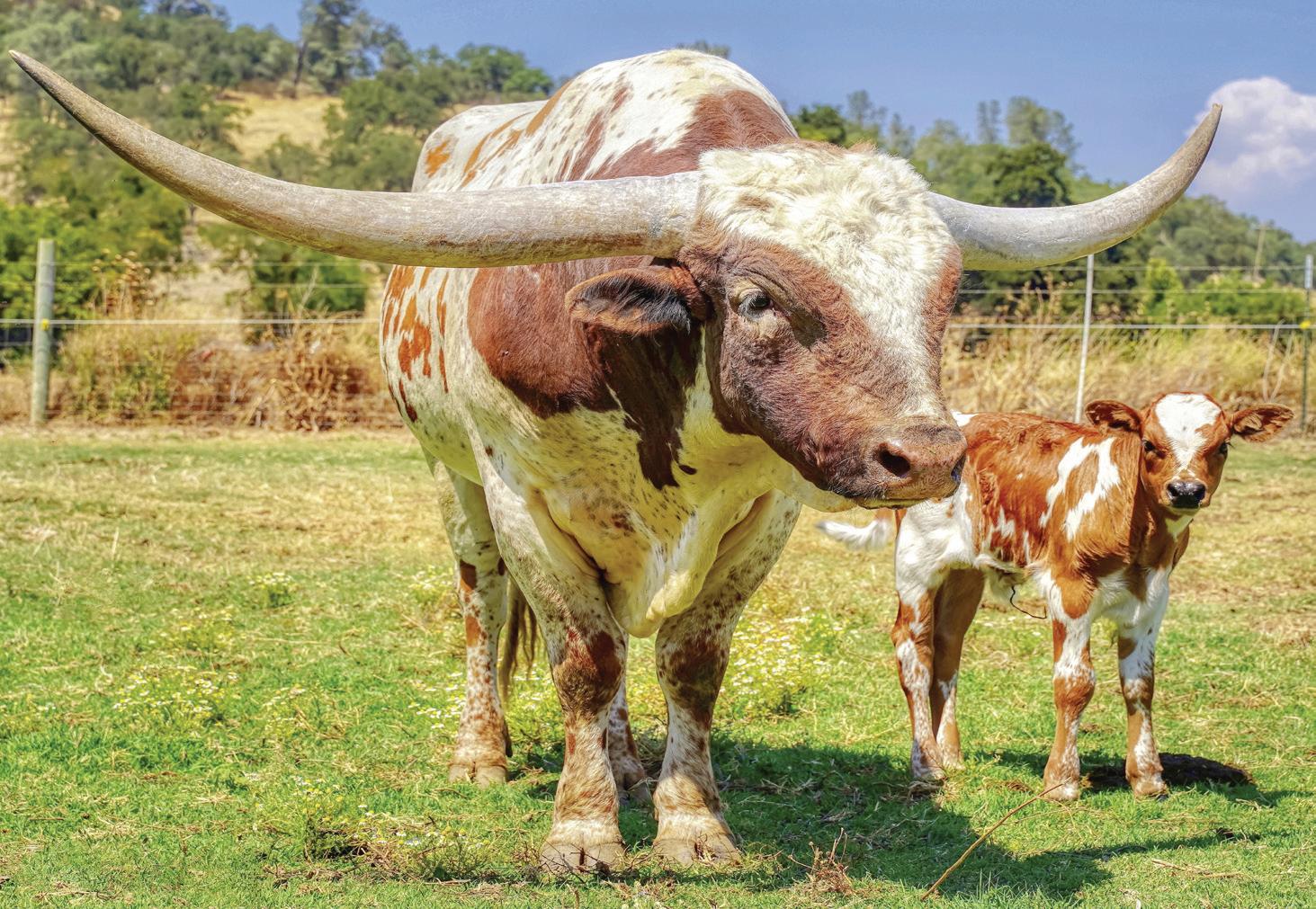
13 minute read
The Longhorn Whisperer - Walk Softly and Consider the Texas Longhorn
Sondra West Moore and Zephyr‘s Arrow- photo by Derek Sample
written by Valerie Laughton, Staff Writer/Producer
Valerie@abpmag.com
Photos by Derek Sample
Westhaven Texas Longhorn Ranch, Ione, CA - Driving over California foothills you drop down into a lush green valley lined with walnut trees on one side and a creek bed in the distance. The fields are dotted with strikingly colored cows, heifers and bulls with their signature crown of horns reaching up to 90 inches and beyond. The Texas Longhorn has had a home on this ranch for over 45 years. It is their haven curated by Colonel Fraser West and now by his daughter Sondra West-Moore. Sondra has an easy way with her herd, walking the pastures daily to check on and hang out with the animals, socializing them so people are able to handle the cattle. She carries her walking stick to “horn communicate” with them in a language they understand. She shows us how when a bull gets a little too close, the cane is like a horn…coming up and showing him go that way or don’t do this. The cows, calves and bulls‘
interest in their new visitors had us mesmerized. A longhorn looks at you and you can see them size you up and seem to process - “What you are doing in my field?” – in their mind. These striking cattle are quite the livestock to behold. Their heads held high, alert and inquisitive, with expansive horns giving way to smaller shoulders and smooth skin sloping up their strong backs to high well defined hips. These are not the wiry animals you see at rodeos. They are

1958 - Colonel Fraser West competing in Hawaii. He was a worldwide team roping Champion
robust and beautiful creatures. But lets get to the why and how of this ranch. As we walk the pasture meeting the longhorns, Sondra West Moore recounts her first memory of a round-up. It was time for shots and branding. She was five and her dad saddled her up on a big horse in front of an open gate amid a swirling herd of 200 longhorn cattle and said, “don’t let anything through this gate”! That was her foray to the love of ranching, given to her by her dad. Her dad was something else. Fraser West turned down West Point to instead study agriculture at the University of Nevada, majoring in, at that time, Animal Husbandry. In 1939 Fraser was a member of the University of Nevada’s First Place US Championship Ski Team. He competed in downhill, slalom, cross-country and ski jumping. His expertise in skiing led him to being a judge and official at five Winter Olympic Games. He was also instrumental in helping to develop the Boreal Ridge ski resort and he introduced the first night skiing in the area because he liked skiing in the dark. He was also a longtime member of the U.S. Ski Association and the International Ski Federation and a recipient of the Hans Georg Award for his positive impact on the sport of skiing. In 1994 he received the USSA’s highest honor, the Julius Blegen Award for prolonged and outstanding service to the sport. Fraser West enlisted in the Marines Crops in 1940 as the first Nevadan in the 1st Marine Officer Candidate Class. As a World War II veteran of Guadalcanal, Bougainville and Guam he was awarded the Silver Star medal for valor and the Purple Heart. During his service overseas in China he began to dream about owning his own ranch in his adoring letters to his wife Teddy, Sondra’s mother. Fraser and Teddy met when she was 4 and he was 12 and he bought his first two horses, one named Happy Days, from Teddy’s mother for $25. He was already competing in rodeos and roping competitions from the age of 12 through 92 and was a Worldwide Military Team Roping Champion more than once. Shoddy design of the arenas irritated him so he designed and built five

Colonel Fraser West at 90, on the ranch
rodeo arenas, including the first ever in Hawaii. Through his years of service in the Marine Corps, Sondra’s mother managed moving the family of six from city to city from tiny apartments to Quonset huts, base housing, tight (for a family of six) tiny houses to small ranches. One day Fraser met with a man about selling one of his custom horse trailers. He designed and manufactured the trailers himself because he wanted something much more sturdy in which to transport his horses and cattle. The man told him about a ranch he had for sale. He took a look at it the next day and knew it was the dream ranch he always wanted. He drove Teddy up to the ranch to see what she thought. After walking the ranch Teddy told her husband that she needed to pray on it. The next day Teddy told him, yes, and Westhaven, in Ione, California was thus sold on a handshake and cash. The rest is history…happily living and growing the ranch together until his passing in 2015. As with everything he approached in life he always strived to make whatever he was making
or doing better. Since 1973 Colonel Fraser West raised Registered Texas Longhorns and continuously worked for the preservation and improvement of this hearty breed. To him, breeding cattle with Longhorns makes your herd healthier. Westhaven Ranch was known for its Grand Champions and ranchers from all over had come to make them part of their herd. Ranchers learned that Colonel Fraser West was right, introducing Longhorns to their herd made their cattle better. When her dad passed in 2015, Sondra told her husband, John Edward Moore, that she had acquired textbooks full of knowledge about Longhorns from working the ranch, taught to her by her dad in addition to her years of 4H showing animals and winning the Round Robin at 13 and a half years old. Sondra thought it was important to pass on her knowledge of Longhorns to others. John loved the idea of working around the ranch. So in 2015, they moved back to the ranch to care for her mother, brother and of course the Longhorns. Her dad had quietly sold Longhorns to Angus and Hereford breeders for years to help them make their herds more disease resistant and heartier. Sondra feels that some new ranchers have Horseshoe J Fascinate &

Horseshoe J Fascinate & Winning Peacemaker Gold (1 day old)
photo by Derek Sample
Westhaven‘s 27 month old Gold Run, already a 3x TLBAA Showcase Champion w/80” horns have forgotten or do not know the would quietly breed their first time contribution Longhorns will make heifers to Longhorns because they to their herds. knew if the cow had a good experi Longhorn cattle date back about ence on her first calf she’s going to 10,000 years ago to East Africa, be a much better cow over the life part of the bloodline migrated to of the cow. They would put LongIndia and some into Spain, which horn genetics into their herd and are related to fighting cattle from that has gone out of fashion and it’s Spain. Longhorns are descendants a disaster as far as I’m concerned, of African animals, which is why because this breed is impervious they can withstand the heat and to ticks, does not get pink eye and snow and they forage on foliage is much more resistant to all kinds that other cattle will not eat. They of things.” Sondra wants to make also have immunity to all sorts of what was old new again. “I really diseases. These animals are highly hope that the genetics of this surevolved. vival breed will get back into the As we walk the pasture we commercial herd because it will come upon a day old calf and her help. Plus their big hips give them protective mom. Sondra tells us more room in the birthing canal.” how Longhorns are very protec Walking through the pasture tive of their calves making them Sondra points out, “this cow is great moms. Longhorns also have from the El Coyote Ranch in smaller heads and shoulders makTexas…this is from the Allen’s ing a first time calving experience Ranch… this one’s grandfather better for the cow and reducing the was Peacemaker, one of the most mortality rate. Having a good first famous bulls… “I buy cattle from experience makes future births all over the place because I want easier. to improve the bloodline. Here is Sondra tells us, “The thing Jamaka, she’s from artificial insemabout longhorns is a few years ago ination from a very famous bull, real cattlemen in the United States Jamakizm. You cannot buy Jam

Westhaven's 27-month old Gold Run, already a 3x TLBAA Showcase Champion with 80" horns
photo by Derek Sample
akizm’s daughters because they are decided to ranch because it was a so rare.” dream of theirs. Longhorns are We turn and the herd has foleasier cattle. You don’t have to lowed us, curious as to what we are vaccinate because they have more doing and seem to be posing for natural resistance, but because pictures. Sondra exclaims, “look she sells across state lines she at the udder on her and people say vaccinates for everything. “I don’t Longhorns don’t produce milk!” believe in not vaccinating because We learn that the swirl above the I saw a steer die of Tetanus and it is eyes on a cow’s head shows intellia terrible death.” Longhorn genetgence, a female’s curly tail is a sign ics are an asset because of their of reproductive health and that the longevity, resistance to disease, fercircumference of the bull’s scrotility, ease of calving and the ability tum is very important as it exhibits to thrive on marginal pasture. They their fertility. She says that she use their horns to forage not just allows the cows to calve in the for protection. same pasture as the bull because it Sondra gestures to the trees on makes a better bull by developing the far side of the pasture showing his gentle, paternal side. how they are trimmed at eight feet Sondra West-Moore also inup due to the Longhorns standing forms us that 61% of the new on their hind feet and knocking ranchers are not from ranching down limbs and leaves to eat. They families, they are just people that eat plants other cattle won’t touch. the Longhorn Whisperer and her prize bull Rusty Smokin Iron

the Longhorn Whisperer and her prize bull Rusty Smokin Iron
photo by Derek Sample
She points out thistles in the pasture that are full of nutrients and tells us that when they start to wilt and die the Longhorn will eat it, in addition to whole heads of artichoke and starthistle. They ignore poisonous mushrooms but will clear out poison oak. Longhorns will clean up a horrible field and make it a healthy, arable land, transforming it into a thick green pasture. The Texas Longhorn Association of America (TLBAA) also has an F1 program for crossbreeding Registered Longhorn into their cattle. It’s another way for new and seasoned ranchers to quietly introduced Longhorn genetics into their herds. Recently, she had calls from cattlemen extremely frustrated with the look of their Angus. These
were big time ranchers that did not like the look of their cattle at the spring gathering and wanted a large amount of F1’s. Sondra suggested that he introduce some Longhorns to his herd. She tells us how the old timers used to constantly introduce Longhorn heifers quietly to their herds knowing how advantageous they were to the health of the herd. She wants ranchers to understand that you may quietly introduce red and black heifers to the herd to make a stronger animal. Sondra finds one of her steers, Captain to be quite interesting. He lets her know when heifers are in heat. She said that he brings a heifer up to the fence line near a bull and then stands at the fence line until the bull takes over. Then, it’s as if Captain acts like, “okay you got it from here” and off he goes. Then she shows us her prize bull, Gold Run, named after the first Ski Resort in California. He’s on day 2 of courting a cow named Donna. Sondra says it is always a four-day courtship. Day 1 they graze next to each other, Day 2 they wink at each other and by Day 4, success. You can always tell what day it is by the way the bull is behaving. Gold Run’s great color, markings and absolutely fantastic horns have earned him the TLBAA Showcase Championship

Baby Boom Iron and Almond Joy (my favorite)
photo by Derek Sample
3 times over, winning all three much longer reproductive life. A categories in his class at just 16 commercial cow is done at 12 or months. He is now 27 months and 13, right? These cows are done at will pass 80” tip to tip before he is 20 or 25…if you let them.” 30 months old. He is considered She goes on to say how people the best son of Gold Mine who is can’t believe how big her bulls one of the most famous bulls and a are - that they are enormous. “I regular trophy winner himself. want people to know that you can After showing us a bull that won raise just as big cattle on grass. A best in class she told us how she Longhorn steer will take 2 months was flabbergasted by the win. Her longer to fatten than a pure Angus husband who helped her so much that goes to a Stockyard. However, on the ranch died a month before it costs less because of their natural the event and she didn’t expect to ability to forage.” win anything. “After his death, this We asked Sondra how she felt ranch saved me. Walking with the about the effect of Covid 19 on the herd and taking care of the anibeef production market. She told mals, I don’t know, they are special. us that Slaughterhouses wouldn’t I grew up with them and my dad take Longhorns because their loved them. There’s something horns will not fit in the chutes, about Longhorns that I’m addictcomplicate that with Covid 19’s ed.” affect on the shut downs of slaugh “I want people to understand if terhouses all over the country. Sonthey buy high quality Registered dra believes that USDA approved Longhorns and breed them into mobile slaughterhouses are going their commercial herd they’re to become the wave of the future going to do nothing but win all the and much more common due to way around. You’re going to spend Covid 19. This enables Longhorns less money feeding them because to be sold for beef consumption they forage better, you’re going to more than in the past, resulting fight off disease better, and you are in an increasing demand for their going to have longer lives and a meat.

Day 1 of courting for Donna and Gold Run
photo by Derek Sample
Sondra says, “Consider the longrun trend, what’s old is new again… they (the Longhorn) have been here thousands of years. Genetically, they’re fascinating because they are one of the few species on the face of the earth that have been domesticated and gone feral several times so they have immunity to all kinds of disease. This is why we need to rebreed them back into commercial herds to make the commercial cattle healthier. That is why I breed Longhorns. Quietly breed them into your herd for a tougher, more disease resistant herd. That‘s my message…consider the Longhorn.” As we drive away from Westhaven Ranch, we realize that just as he had done with everything in life, Colonel Fraser West, always worked hard to improve on any endeavor he undertook. He brought up his daughter to be just like him. Sondra West-Moore strives to improve on all her endeavors. We are pretty certain that her dad and husband are watching over the ranch, proud of her achievements. We leave Westhaven Ranch agreeing with Sondra, that you should definitely…consider the Longhorn.

Fast Win & Fast Smokin Iron
photo by Derek Sample

Clear Dixie Mist “a picture perfect 3 month old registered Longhorn heifer. Beefy, feminine, clean lines, and would go well with Charolaisfor cross-breeding”
photo by Derek Sample

3 yearling heifers Fast Times Iron, Clear Reverie & Swift Win
photo by Derek Sample

Andalusia Iron
photo by Derek Sample


